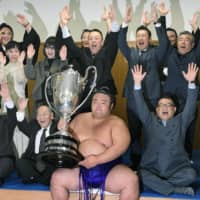On the surface sumo generates income the same way as most other sports —through ticket sales, merchandising and sponsorships.
While that's the case for the Japan Sumo Association on a macro level; individually, stables and wrestlers also rely on another source of funding — supporters groups.
Koenkai, as they are known, have long played a major role in subsidizing and promoting Japan's national sport.
Stables with several large supporters groups tend to be the most successful when it comes to finding and recruiting new talent.
Sekitori (wrestlers in the top two divisions) traditionally have also relied on their koenkai for everything from paying for ceremonial aprons to financing the purchase of a toshiyori-kabu (elder name share).
In recent times, many stables have created western-style fan clubs that can be joined online with clear pricing structures and rewards.
Those are separate from the koenkai, whose members often come through personal introduction.
People in the latter group also tend to be a lot wealthier and contribute far greater sums.
When talking to koenkai members I've found many were sumo fans in their youth, and having become financially successful, want to give back to the sport that provided so much entertainment when they were children.
Wealthy supporters that regularly take wrestlers out to expensive restaurants, purchase gifts and provide significant financial help are called Tanimachi.
That moniker comes from the street of the same name in Osaka where a doctor once provided free medical care for wrestlers and gave them money.
Support group members are normally out of the public eye, but when a wrestler wins a championship, and is photographed in the dressing room holding the Emperor's Cup, many of those behind him doing the banzai cheer are part of his koenkai.



















With your current subscription plan you can comment on stories. However, before writing your first comment, please create a display name in the Profile section of your subscriber account page.